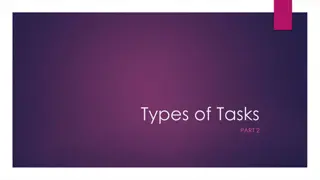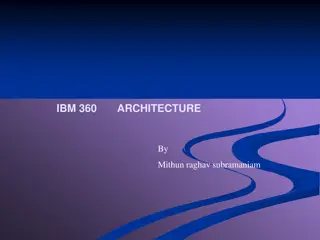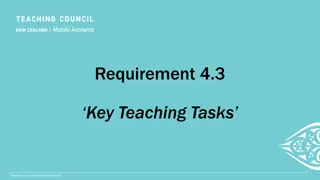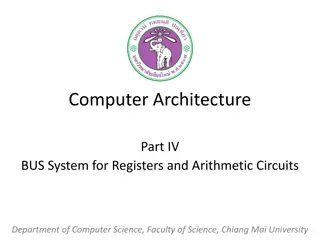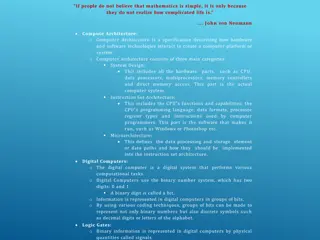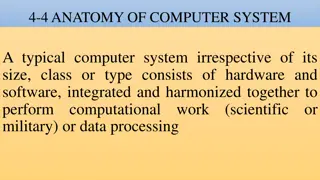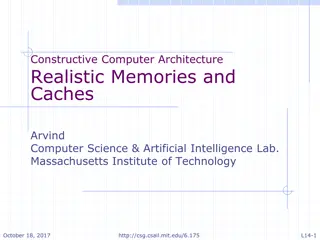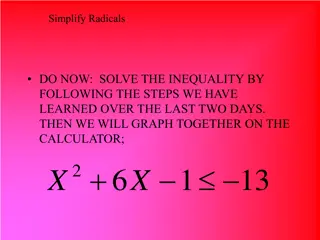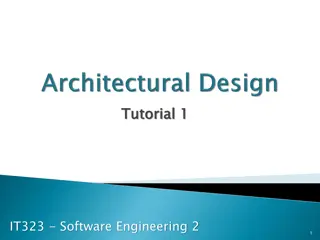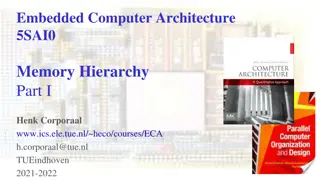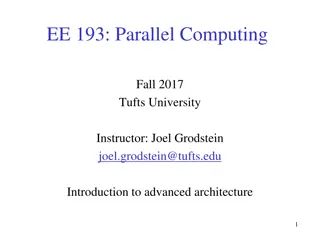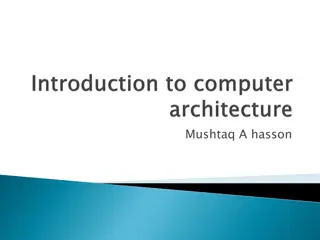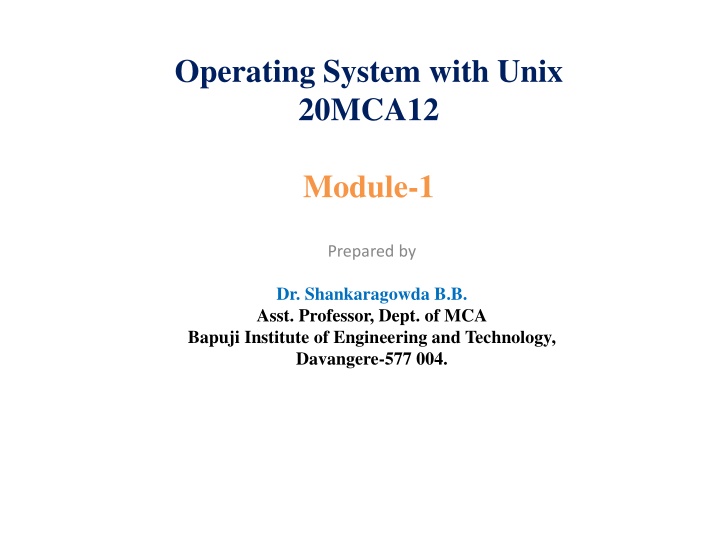
Computer System Architecture: Simplifying Tasks with Efficiency
A computer system, managed by an operating system, serves as a mediator between users and hardware. Learn about OS operations like process management, memory management, and more. Discover how OS structures impact system functionality and performance.
Uploaded on | 0 Views
Download Presentation

Please find below an Image/Link to download the presentation.
The content on the website is provided AS IS for your information and personal use only. It may not be sold, licensed, or shared on other websites without obtaining consent from the author. If you encounter any issues during the download, it is possible that the publisher has removed the file from their server.
You are allowed to download the files provided on this website for personal or commercial use, subject to the condition that they are used lawfully. All files are the property of their respective owners.
The content on the website is provided AS IS for your information and personal use only. It may not be sold, licensed, or shared on other websites without obtaining consent from the author.
E N D
Presentation Transcript
Operating System with Unix 20MCA12 Module-1 Prepared by Dr. Shankaragowda B.B. Asst. Professor, Dept. of MCA Bapuji Institute of Engineering and Technology, Davangere-577 004.
What is an Operating System? An operating system is a system software that acts as an intermediary between a user of a computer and the computer hardware. It is a software that manages the computer hardware. Operating System (Os) allows the user to execute programs in a convenient and efficient manner.
Computer System Architecture A computer system is basically a machine that simplifies complicated tasks. It should maximize performance and reduce costs as well as power consumption. The different components in the Computer System Architecture are Input Unit, Output Unit, Storage Unit, Arithmetic Logic Unit, Control Unit etc. A diagram that shows the flow of data between these units is as follows:
Computer System Architecture Layered OS Architecture
Operating System Operations The major operations of the operating system are process management, memory management, device management and file management. These are given in detail as follows: Process Management, Memory Management, Device Management & File Management.
Operating System Structure Operating system can be implemented with the help of various structures. The structure of the OS depends mainly on how the various common components of the operating system are interconnected and melded into the kernel. Depending on this we have following structures of the operating system: MS-DOS is an example of such operating system. In MS-DOS application programs are able to access the basic I/O routines. These types of operating system cause the entire system to crash if one of the user programs fails. Diagram of the structure of MS-DOS is shown below.
Operating System Structure Layered structure: An OS can be broken into pieces and retain much more control on system. In this structure the OS is broken into number of layers (levels). The bottom layer (layer 0) is the hardware and the topmost layer (layer N) is the user interface. These layers are so designed that each layer uses the functions of the lower level layers only.
Operating System Services An Operating System provides services to both the users and to the programs. It provides programs an environment to execute. It provides users the services to execute the programs in a convenient manner. Following are a few common services provided by an operating system : Program execution I/O operations File System manipulation Communication Error Detection Resource Allocation Protection
System Calls Types of System Calls A system call is a mechanism that provides the interface between a process and the operating system. It is a programmatic method in which a computer program requests a service from the kernel of the OS. Types of System calls Here are the five types of system calls used in OS: Process Control File Management Device Management Information Maintenance Communications
System Programs System Programming can be defined as act of building Systems Software using System Programming Languages. According to Computer Hierarchy, one which comes at last is Hardware. Then it is Operating System, System Programs, and finally Application Programs. Program Development and Execution can be done conveniently in System Programs. Some of System Programs are simply user interfaces, others are complex. It traditionally lies between user interface and system calls.
Virtual Machines A Virtual Machine (VM) is a compute resource that uses software instead of a physical computer to run programs more virtual guest machines run on a physical host machine. machine runs its own operating system and functions separately from the other VMs, even when they are all running on the same host. This means that, for example, a virtual MacOS virtual machine can run on a physical PC. and deploy apps. One or Each virtual The two types of virtual machines A process virtual machine allows a single process to run as an application on a host machine, providing a platform-independent programming environment by masking the information of the underlying hardware or operating system. An example of a process VM is the Java Virtual Machine, which enables any operating system to run Java applications as if they were native to that system. A system virtual machine is fully virtualized to substitute for a physical machine. A system platform supports the sharing of a host computer s physical resources between multiple virtual machines, each running its own copy of the operating system. This virtualization process relies on a hypervisor, which can run on bare hardware, such as Vmware ESXi, or on top of an operating system.
System boot After an operating system is generated, it must be made available for use by the hardware. But how does the hardware know where the kernel is or how to load that kernel? The procedure of starting a computer by loading the kernel is known as booting the system. On most computer systems, a small piece of code known as the bootstrap program or bootstrap loader locates the kernel, loads it into main memory, and starts its execution. Some computer systems, such as PCs, use a two-step process in which a simple bootstrap loader fetches a more complex boot program from disk, which in turn loads the kernel.
Process Scheduling The process scheduling is the activity of the process manager that handles the removal of the running process from the CPU and the selection of another process on the basis of a particular strategy. Process scheduling is an essential part of a Multiprogramming operating systems. Such operating systems allow more than one process to be loaded into the executable memory at a time and the loaded process shares the CPU using time multiplexing. Process Scheduling Queues The OS maintains all PCBs in Process Scheduling Queues. The OS maintains a separate queue for each of the process states and PCBs of all processes in the same execution state are placed in the same queue. When the state of a process is changed, its PCB is unlinked from its current queue and moved to its new state queue. The Operating System maintains the following important process scheduling queues : Job queue This queue keeps all the processes in the system. Ready queue This queue keeps a set of all processes residing in main memory, ready and waiting to execute. A new process is always put in this queue. Device queues The processes which are blocked due to unavailability of an I/O device constitute this queue.
Scheduling Algorithms A Process Scheduler schedules different processes to be assigned to the CPU based on particular scheduling algorithms. There are six popular process scheduling algorithms : First-Come, First-Served (FCFS) Scheduling Shortest-Job-Next (SJN) Scheduling Priority Scheduling Shortest Remaining Time Round Robin(RR) Scheduling Multiple-Level Queues Scheduling
Process Synchronization On the basis of synchronization, processes are categorized as one of the following two types: Independent Process : Execution of one process does not affects the execution of other processes. Cooperative Process : Execution of one process affects the execution of other processes. Process synchronization problem arises in the case of Cooperative process also because resources are shared in Cooperative processes. Race Condition When more than one processes are executing the same code or accessing the same memory or any shared variable in that condition there is a possibility that the output or the value of the shared variable is wrong so for that all the processes doing the race to say that my output is correct this condition known as a race condition.
Critical Section Problem Critical section is a code segment that can be accessed by only one process at a time. Critical section contains shared variables which need to be synchronized to maintain consistency of data variables. In the entry section, the process requests for entry in the Critical Section.
Text book Abraham Silberschatz, Peter Baer Galvin, Greg Gagne: Operating Systems Principles, 8th Edition, Wiley India. Reference book P C P Bhatt: Operating Systems, 2ndEdition, PHI, 2006.

![❤Book⚡[PDF]✔ The Apollo Guidance Computer: Architecture and Operation (Springer](/thumb/21611/book-pdf-the-apollo-guidance-computer-architecture-and-operation-springer.jpg)


